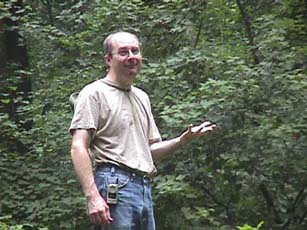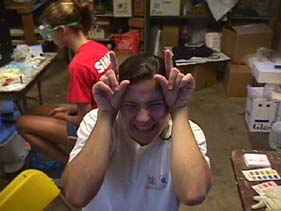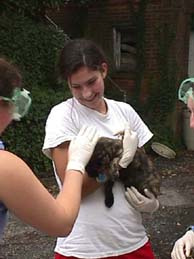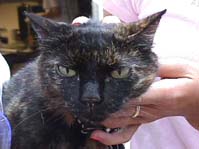Mollusks
Galore!
Hello, this is Annabel, Molly, Sara and Susanna's site on mollusks. Enjoy!!!
 :
:


Suzifer being devilish Suzifer attempting to possess "Sparkles"
Procedure:
1. Locate thirteen different sites where you can take soil samples. For example: one near a wooded area and another near a pond, etc.
2. Take a soil sample from each site using a core sampler to the first mark (15 cm). Use gloves to remove the soil into a plastic bag sealed and labeled with the site number.
3. Label each site by marking with a flag. For our flags we placed a plastic glove over a stick, which worked very well.
4. In order to attract the mollusks, purchase snail bait, which can be found in any hardware store. Place 20 grams of snail bait in a pile at each site. Cover bait with cheesecloth. Wet the cheesecloth until saturated.
5. Leave traps for at least 60 hours. After time has passed, go back to sites and count the number of mollusks. Record data.
6. Test each sample for calcium in parts per million. We recommend using the LaMotte soil test kit.
7. Test each sample for pH. Again, we recommend using the LaMotte soil test kit.
8. Graph results and note correlation. We graphed the mollusk vs pH data on one graph; the mollusk vs calcium data on a second graph; and the calcium vs pH data on a third graph.
Troubleshooting:
While trying to "catch" the mollusks we ran into some problems. Make sure not to use plastic containers to hold the bait, or any containers, simply place it on the soil and cover it with cheesecloth. The mollusks should not die but should still come for the bait.
When looking for the mollusks you might want to use a magnifying glass because the mollusks are very small and can sometimes look like dirt.
Make sure you wear gloves while handling the snail bait because it is very toxic to the skin. DO NOT CONSUME!
Also, you should measure your snail bait BEFORE you go into the field and keep it in separate plastic bags.
Sample Results:
| Susanna Ingalls, Molly Malloy, Annabel Acs, Sara Katz | |||||||
| PH Data | |||||||
| Sample | Duplex Indicator | Specific Indicator | |||||
| 1 | 8 | 7.2 | |||||
| 2 | 7 | 6.4 | |||||
| 3 | 8 | 7.2 | |||||
| 4 | 5 | 4.2 | |||||
| 5 | 7 | 6.4 | |||||
| 6 | 7 | 7.2 | |||||
| 7 | 8 | 7.2 | |||||
| 8 | 7 | 6.4 | |||||
| 9 | 7 | 7.2 | |||||
| 10 | 8 | 7.2 | |||||
| 11 | 8 | 7 | |||||
| 12 | 6 | 5.4 | |||||
| 13 | 8 | 7.2 | |||||
| Calcium Data | |||||||
| Sample | |||||||
| 1 | 1400ppm | ||||||
| 2 | 150ppm | ||||||
| 3 | 1400ppm | ||||||
| 4 | 0ppm | ||||||
| 5 | 150ppm | ||||||
| 6 | 1000ppm | ||||||
| 7 | 700ppm | ||||||
| 8 | 0ppm | ||||||
| 9 | 1000ppm | ||||||
| 10 | 700ppm | ||||||
| 11 | 7700ppm | ||||||
| 12 | 150ppm | ||||||
| 13 | 2300ppm | ||||||
| Mollusks Data | |||||||
| Sample | Day 1 | ||||||
| Both | Snails | Slugs | |||||
| 1 | 3 | 3 | 0 | ||||
| 2 | 2 | 0 | 2 | ||||
| 3 | 0 | 0 | 0 | ||||
| 4 | 4 | 2 | 2 | ||||
| 5 | 6 | 0 | 6 | ||||
| 6 | 3 | 0 | 3 | ||||
| 7 | 24 | 0 | 24 | ||||
| 8 | 1 | 0 | 1 | ||||
| 9 | 15 | 0 | 15 | ||||
| 10 | 1 | 1 | 0 | ||||
| 11 | 0 | 0 | 0 | ||||
| 12 | 0 | 0 | 0 | ||||
| 13 | 4 | 0 | 4 | ||||
| Statistics | |||||||
| PH | Calcium | Mollusks | |||||
| mean | N/A | 842.307 | 4.846 | ||||
| meadian | 7.2 | 700 | 3 | ||||
| mode | 7.2 | 150 | 0 | ||||
| maximum | 7.2 | 2300 | 24 | ||||
| minimum | 4.2 | 0 | 0 | ||||
| range | 3 | 2300 | 24 | ||||
| std. Deviation | N/A | 735.591 | 6.724 | ||||
| std. Error | N/A | 1286.858 | 397.756 | 8.91 | 0.782 | ||
| variable | N/A | 541049.1 | 45.212 | ||||
Bibliography: Follow this link for more information
Hall, Geoffry S.. (1996) Methods for the Examination of Organismal Diversity in Soils and Sediments. New York: Cab International.
“Soil Health.” [Available Online], http://ice.agric.uwa.edu.au/soils/soilhealth/organic/index.htm ; 2001
“Microbe Zoo, Dirtland.” [Available Online], http://commtechlab.msu.edu/sites/dlc-me/zoo/zdmain.html ; 2000
“The Soil Foodweb: It's Importance in Ecosystem Health.” [Available Online], http://www.rain.org/~sals/ingham.html ;undated
“Microbiology of Agricultural Soils.” [Available Online], http://www.ucc.ie/impact/agri2f.html#ecosystem ; undated
“Soil Fauna and Agriculture: Past Findings and Future Priorities” [Available Online] http://eap.mcgill.ca/Publications/EAP25.htm ;1985
Ingham, Elaine R. "Chapter 3: Bacteria- The Living Soil: Bacteria." [Available Online] http://www.statlab.iastate.edu/survey/SQI/SoilBiology/bacteria.htm; February 2001.
Lipscomb, Diana. "Protozoa."
[Available Online] http://biology.usgs.gov/s+t/noframe/m2083.htm; Date N/A.
Kirkby,
Clive. "Biodiversity, Soil and Ecologically Sustainable
Development." [Available Online]
Borden,
Dr. Robert C. "Protozoan grazing to be investigated as an important control
on rate of biodegradation of hydrocarbon contaminants." [Available Online] http://www2.ncsu.edu/ncsu/CIL/WRRI/annual/97borden.html; June 1997.
Contact (Project Director):

Sparkles!!!!